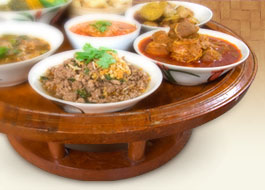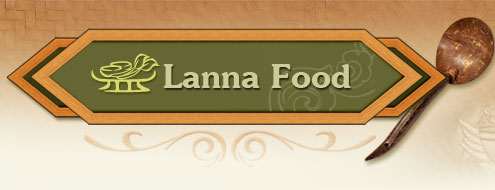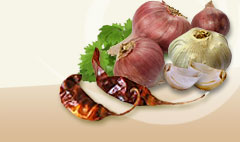Bitter eggplant |
|
|
 | Solanum incanum L. S |
|
| |
 | Solanaceae |
|
| |
 | Bitter eggplant |
|
| |
 | Ba khuea chae, Ba khuea huen (Rattana Phromphichai, 1999, p. 868), ma khuea huen (Kanchana Diwiset, et al., comp., 2005, p. 175) |
|
| |
 | Shrub, 1-3 m. high, stalk round, green. Leaves hairy and thorny. Flowers recimes, axillary, bisexual, purple, hairy. Fruit round, 3-5 cm. diameter. Fruit yellowish green when ripe, leathery; seeds numerous, round, flat, bearing fruit year round. (Rattana Phromphichai, 1999, p. 868) |
|
| |
 |

100 gm. contains calcium 55 mg., phosphorus 22 gm., Vitamin C 63 mg. (Phak Phuen Ban Ahan Thai, 2005, 206) Fruit tastes a little bitter. Young fruit are eaten raw by Lanna people or made into namphrik to make namphrik i-ke, namphrik ba khuea chae. Ripe fruit is grilled and minced to add to lap (beef or pork) for an extra texture (Rattana Phromphichai, 1999, 868). People in the Central region eat it with namphrik (raw or blanched) or sliced into kaeng pa. (Kanchana Diwiset, et al., comp., 1999, p. 187; Phak Phuen Ban Ahan Thai, 2007, p. 206) Isan people add it to som phak and som tam. (Aram Khumklang, et al., comp., 1998, p. 197) |

Roots used as an expectorant, for dry saliva, to reduce fever (Wut Wuthithamwet, 1997, p. 348)
The fruit contains alkaloids. Lanna medicine uses it as a stamina booster, an expectorant, dermatology therapy, expel cough and phlegm, treat boils and sore, a sex booster. It can cause difficulty to a woman while giving birth. (Rattana Phromphichai, 1999, p. 868)
|
|
| |
 | All year round |
|
| |
 |
Kanchana Diwiset, et al., comp. (1999). Phak Phuen Ban Phak Klang. Kanchana Diwiset, ed. Nonthaburi: Project on Text Development, Institute for Traditional Thai Medicine. (in thai). . (2005). Phak Phuen Ban Phak Nuea. Phennapha Sapcharoen, ed. (2nd ed). Nonthaburi: Center for Text Development on Traditional Thai Medicine. (in thai). Phak Phuen Ban Ahan Thai. (2005). Bangkok: Saengdaet. (in thai). Rattana Phromphichai. (1999). Khuechae, Ba. inSaranukrom Wattanatham Thai Phak Nuea (Vol. 2,p. 868). Bangkok: Siam Commercial Bank Foundation for the Encyclopedia of Thai Culture. (in thai). Wut Wuthithamwet. (1997). Saranukrom Samunphrai: Ruam Lak Phesatchakam Thai. Bangkok: Odean Store. (in thai). Aram Khumklang, et al., comp. (1998). Phak Phuen Ban Phak Isan. Kanchana Diwiset and Aram Khumklang, eds. Nonthaburi: Project on Text Development, Institute for Traditional Thai Medicine. (in thai). |
|
| |
|
|




